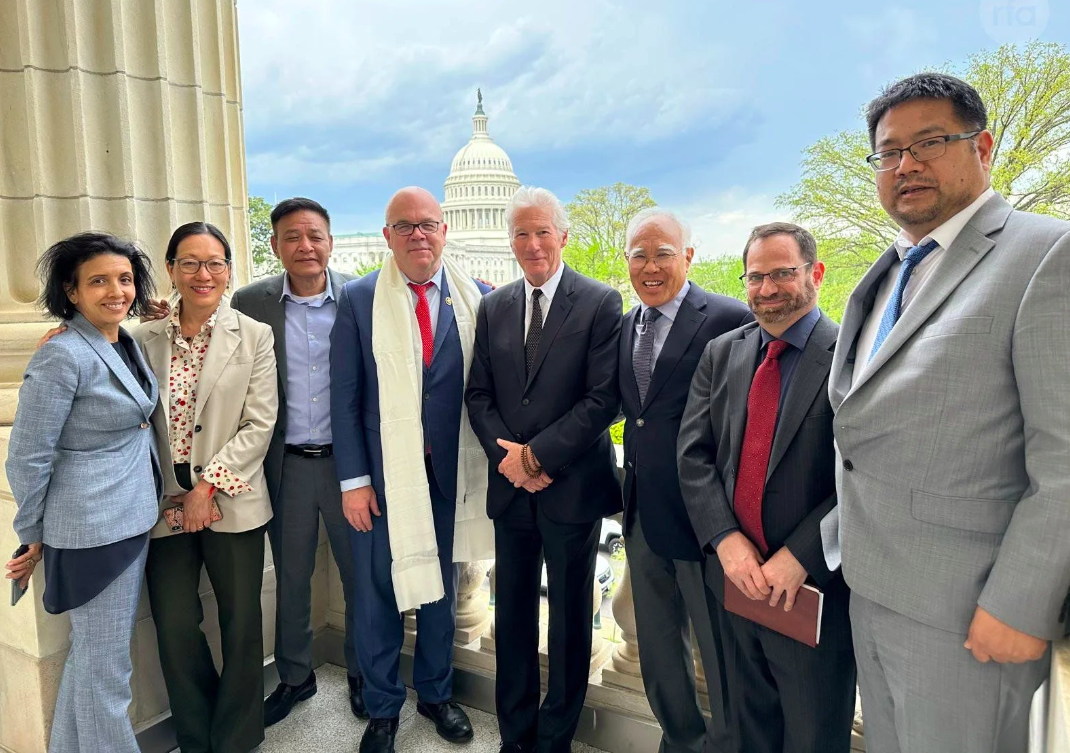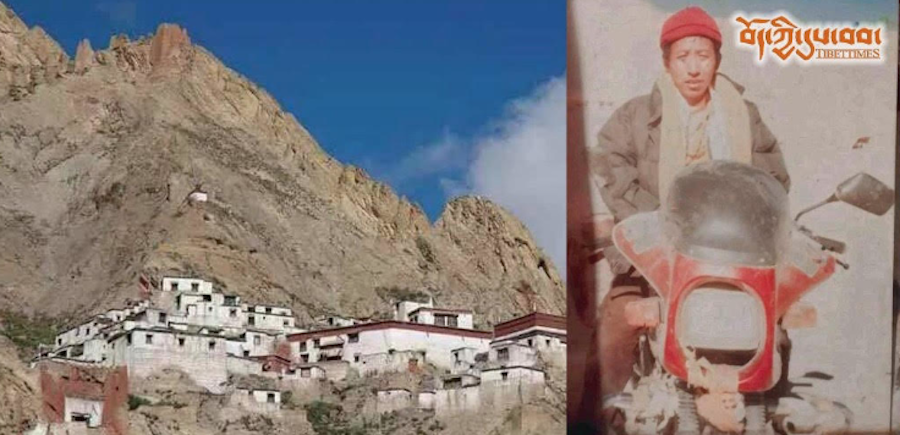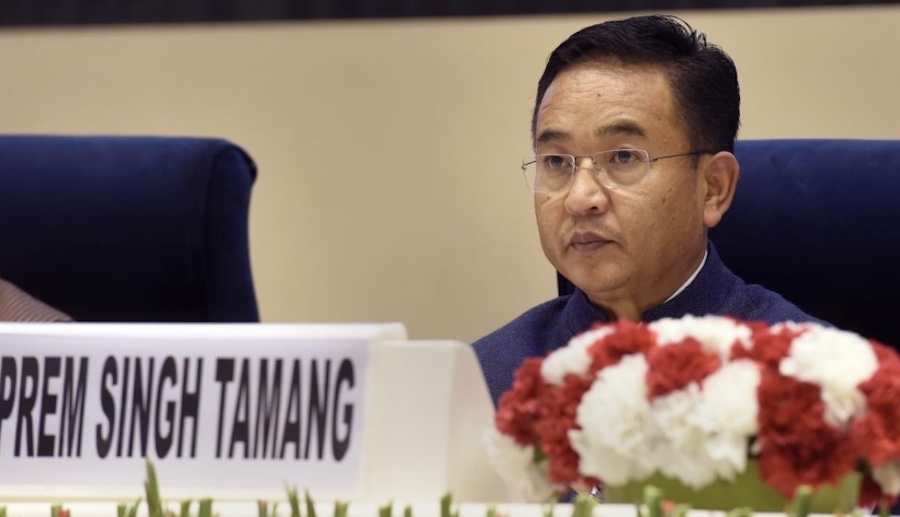By Topden Tsering
 In a week’s time, Tenzin Sonam and Ritu Sarin’s film, Dreaming Lhasa, will have its limited screening in theaters across the United States. For any Tibetan and supporters and lovers of good cinema, this is a chance not to be missed.
In a week’s time, Tenzin Sonam and Ritu Sarin’s film, Dreaming Lhasa, will have its limited screening in theaters across the United States. For any Tibetan and supporters and lovers of good cinema, this is a chance not to be missed.
Dreaming Lhasa is technically a road movie; its story essentially about searching. At the heart of the film is the mystery surrounding a Ghawu:Who does it belong to? What story and what history would the revelation unearth, about what person and which people? And more immediately, what bearing the answer would have on the life of Dhondup, who has come to Dharamsala from Tibet to fulfill a wish he had granted his mother on her deathbed, minutes after she had handed him this relic from an unknown past?
Ghawu is a charm box, blessed by high lamas, traditionally worn for good luck and protection. The amulet has been made legendary by its life-saving power through real-life experiences of CIA-backed Tibetan resistance fighters in the sixties and seventies, and the Bangladesh Tibetan war veterans in 1971.
The Ghawu here is more than a cryptic puzzle screaming for resolution. It is a metaphor for the very plight daunting the Tibetans today: the violence that China’s military occupation has wrought on a people both sides of the Himalayas: in the uprootedness of a generation now all but vanishing, and with them a way of life; in the identity crises of their children, younger by age, weaker by faith, and enfeebled by circumstances; and in the multifarious versions of flight, both in mind and physical space, that occupation and exile entail.
 And it is this twin impetus – occupation and exile – that makes people leave homes, undertake journeys and cross borders. Some as in the case of Karma, the woman documentary filmmaker from the United States, to reconnect with her past, the place of her origin, Tibet, by inhabiting an idea of it which is Dharamsala. Some as in the case of Dhondup to find answers to a mystery that death had bequeathed him and which during life had kept hidden from him. And some as in the case of Jigme, a local vagabond, with all his ready charm and inborn rebelliousness, to just be somewhere else, anywhere else, but here.
And it is this twin impetus – occupation and exile – that makes people leave homes, undertake journeys and cross borders. Some as in the case of Karma, the woman documentary filmmaker from the United States, to reconnect with her past, the place of her origin, Tibet, by inhabiting an idea of it which is Dharamsala. Some as in the case of Dhondup to find answers to a mystery that death had bequeathed him and which during life had kept hidden from him. And some as in the case of Jigme, a local vagabond, with all his ready charm and inborn rebelliousness, to just be somewhere else, anywhere else, but here.
Karma too is on a mission of her own, to make a documentary about former political prisoners. After each interview, with nuns who had been arrested for shouting slogans, with monks who had been imprisoned for distributing flyers; after each remembrance and recounting, of blows and humiliation: hands across face, cattle prod inside vagina, it is like unto the US-returned expatriate is passed, in the solitude of her sparse hotel room, the impact, the wound, the damage. It shows in the silence and in the sigh, and in such insignificant and asymmetrical shot as her glasses resting on a camera tripod.
Despite her pain, there is about Karma a certain purpose, which as she sets about her business takes on the form of an unmistakable resoluteness; a will to accomplish. And it is this quality that makes her want to throw her lot with Dhondup, in who she finds everything which is pure and right, as if he were not a person but the very embodiment of her vast unseen country, the id of her idealism. Her emerging detail, as a mother of a girl with an American man with who her relationship is strained, only adds to the poignancy.
Her at-will assistant, an adept navigator through the psychedelic corridors of Dharamsala’s Mcleod Gunj, is a local chutzpah-laden youth, Jigme. With long disheveled hair and a rock star swagger, clad in vintage denim Jacket and torn jeans, he is the quintessential exile youth. Having his fancy set on Karma, it is for obvious reasons that he is irked by her growing fondness for Dhondup. But it is also because in life if he has learnt anything it is to be skeptical, to not give in to appearances, while belying his own with a ready smile. For a place the smallness of Dharamsala, he appears cosmopolitan, so much so he even wears his handicap, his limp, almost like an accessory.
The characters having been established, the film now takes us on the road. It leads us to Delhi and the Tibetan settlement of Clement Town and the desert city of Jaipur, where resides an elderly and ailing Tibetan sweater seller with his family, their rented quarter cramped with garments in squeaky plastic bags. One finger points to another, one clue to next, before they finally locate the owner of the Ghawu, and it is his identity and his back story and the circumstances under which the amulet came to be in the hands of Dhondup’s mother that renders the film’s climax portent and powerful and profound.
The film has been shown and lauded at thirty-plus film festivals around the world, including the prestigious Toronto Film Festival where it made its international debut, alongside such critically-acclaimed fares as Ang Lee’s Brokeback Mountain and Deepa Mehta’s Water, and in many it has won the audience favorite vote. It takes little to understand why.
For one, the film refuses to dabble in hysteria (Take note, makers of Pun Anu Thanu and Milarepa). The narrative thread is contained within a structure that is impeccable, and throughout one observes a certain economy of words, gesture, shot duration, which is but the result of a finely-executed storyboard, and because of which every frame becomes worthwhile, every scene inevitable. The characters here actually talk, not rant; they perform, not exaggerate; the emotion is here subdued and not a contortionist’s spectacle; and instead of letting jargon-filled winding monologues do the job, the filmmakers let the interaction among characters and the dynamics of their situations establish and move forward the story.
Dreaming Lhasa is imaginative without being preposterous and realism is its biggest USP, a strength that owes to the filmmakers’ background in documentaries. Former political prisoners play themselves; their brutal past is portrayed simply through close ups and voiceovers, as captured on a video camera. For all her anguish and awakening, when the time comes, Karma returns to America, the country which had inscribed upon her identity a million questions, leaving behind Dharamsala, her idea of Tibet, without Dhondup or Jigme; without love, without absolution.
For all his past, of courageous resistance and blood-dripping sacrifices, Dhondup makes no affectations of a grand plan for the freedom struggle which in exile he finds has become a subject for sweeping, sometimes mocking, commentaries by his counterparts, the likes of Jigme and company. He indulges in no reprimands; instead he minds his own business and trudges onward, with his eyes set backward on his enslaved land where lives his wife with his newborn child, the only future he has and he knows of.
On the surface, Jigme is a typical Dharamsala delinquent, full of amorous streaks and if not bedding Westerner tourist women, then smoking pot, drinking beer and shooting pool. A hybrid between a fractured past and fleeting present, one conversant beyond detection in the affectations of accent and attitude, the very disguise with which to give his self relevance and visibility. But when inspiration strikes him, he takes to the guitar and belts out an anthem of his own, “Zugu ruko naza tangwa, nying la sugpo gangda du, ga dang dukpo gangda du, sosoe mitse kyipo duk pe (I play till my finger joints hurt, tell me how deep I strike in your heart, how much of pain and joy do you feel, are you happy with your life?)”
It is to the film’s great advantage that the filmmakers incorporate Jigme’s character with his real-life nemesis’ passion and profession. Actor Tenzin Jigme is part of a popular three-member band “JJI Exile Brothers”, all real siblings, whose music combine Western rock and traditional Tibetan influences. In the age of effeminate vocals, their hand-me-down lyrics stilted in honorific vocabulary of the yore, which proliferate the modern Tibetan music scene, JJI’s in-your-face, don’t-take-no-prisoner, fart-if-you-feel-like-it, variation is a refreshing departure.
The film’s innovative soundtrack also includes such jarring accompaniments as a Bollywood oldie “Aghe bhi Jaane na tu, peeche bhi jaane na tu, jo bhi hai, bas yahi ek pal hai (what is in front of you, you do not know; what is behind you, you do not know; what there is to it, is this just one moment)” and a strange fusion genre, Dub. A fitting ode to the ambivalence that is exile experience.
Among the actors, Jampa Kalsang who plays Dhondup is phenomenal. He is perhaps a true movie actor we have in the Tibetan world, one with a face an actual reminiscent of the country’s anguished fate. From Windhorse to Dreaming Lhasa, the artist has come a long way, and somebody ought to give him an Achievement Award already. Tenzin Jigme is a delightful revelation and Tenzin Chokyi Gyatso, who plays karma, holds her own admirably.
Finally, the film’s greatest achievement is its deep meditation on that enduring measure of loss, beyond occupation and exile, in the labyrinthine thicket of which we thrash everyday and yet we sometimes so easily overlook, called time. It pays a fitting homage to the sacrifices made by our father’s generation, especially those who were part of the CIA-backed Tibetan resistance fighters, that soldiered on amid a barrage of Chinese bullets, with a hope of leaving behind for us, a living struggle, a fight not yet surrendered.
It plays on their real experiences, their hard won wisdom, and their vanishing turn as an ancient generation; and it asks of the younger lot a most strident question: what end are we going to give to their sacrifices?









